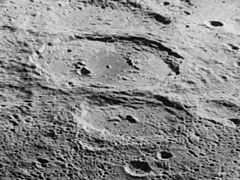Antoniadi (lunar crater)
|
Oblique Lunar Orbiter 5 image facing west of Antoniadi (above center) and Numerov (below center) | |
| Coordinates | 69°42′S 172°00′W / 69.7°S 172.0°WCoordinates: 69°42′S 172°00′W / 69.7°S 172.0°W |
|---|---|
| Diameter | 143 km |
| Depth | 9 km |
| Colongitude | 172° at sunrise |
| Eponym | Eugène M. Antoniadi |
Antoniadi is a large lunar impact crater that lies on the southern hemisphere on the far side of the Moon. The crater intrudes into the southeastern rim of the crater Minnaert, a slightly smaller formation that is significantly more eroded. Attached to the eastern rim of Antoniadi is Numerov, another large, ancient crater similar to Minnaert. Due south of Antoniadi is the small crater Brashear.
Geography
The outer rim of Antoniadi is generally circular, with an irregular edge that has multiple indentations all about the perimeter. The wall is only lightly eroded, and retains a crisp rim and terracing on the inner walls. Only a single small craterlet of note lies across the interior wall, near the southeast edge of the rim.
Antoniadi is one of the few craters on the Moon that possesses both a second inner ring and a central peak. This inner ring formation is about half the diameter of the outer wall, and only rugged mountain segments of the ring to the north and south still remain. The western part of the inner ring is almost non-existent, and only a few minor hills remain to the east.
The floor within the inner wall is unusually flat and smooth, with the central peak being the only notable feature. The floor outside the inner ring is much rougher in texture. The most notable crater on the interior floor lies across the eastern edge of the southern inner ring range.
The bottom of Antoniadi crater is measured—by using the laser altimeter (LALT) instrument on board the Japanese Selenological and Engineering Explorer (SELENE) satellite—to be the lowest point on the moon and rests 9 kilometers (more than 5.5 miles) deep.[1]
References
Cited
- ↑ "New High-Res Map Suggests Little Water Inside Moon". Ohio State University. Retrieved February 12, 2009. To coincide with publication in the journal Science.
General
- Andersson, L. E.; Whitaker, E. A. (1982). NASA Catalogue of Lunar Nomenclature. NASA RP-1097.
- Blue, Jennifer (July 25, 2007). "Gazetteer of Planetary Nomenclature". USGS. Retrieved 2007-08-05.
- Bussey, B.; Spudis, P. (2004). The Clementine Atlas of the Moon. New York: Cambridge University Press. ISBN 978-0-521-81528-4.
- Cocks, Elijah E.; Cocks, Josiah C. (1995). Who's Who on the Moon: A Biographical Dictionary of Lunar Nomenclature. Tudor Publishers. ISBN 978-0-936389-27-1.
- McDowell, Jonathan (July 15, 2007). "Lunar Nomenclature". Jonathan's Space Report. Retrieved 2007-10-24.
- Menzel, D. H.; Minnaert, M.; Levin, B.; Dollfus, A.; Bell, B. (1971). "Report on Lunar Nomenclature by the Working Group of Commission 17 of the IAU". Space Science Reviews 12 (2): 136–186. Bibcode:1971SSRv...12..136M. doi:10.1007/BF00171763.
- Moore, Patrick (2001). On the Moon. Sterling Publishing Co. ISBN 978-0-304-35469-6.
- Price, Fred W. (1988). The Moon Observer's Handbook. Cambridge University Press. ISBN 978-0-521-33500-3.
- Rükl, Antonín (1990). Atlas of the Moon. Kalmbach Books. ISBN 978-0-913135-17-4.
- Webb, Rev. T. W. (1962). Celestial Objects for Common Telescopes (6th revised ed.). Dover. ISBN 978-0-486-20917-3.
- Whitaker, Ewen A. (1999). Mapping and Naming the Moon. Cambridge University Press. ISBN 978-0-521-62248-6.
- Wlasuk, Peter T. (2000). Observing the Moon. Springer. ISBN 978-1-85233-193-1.
